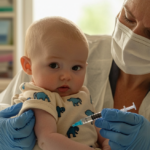
Nawał pokarmu – co musisz wiedzieć?
Spis treści:
Jakie są objawy nawału pokarmu?
Nawału pokarmu nie sposób nie zauważyć. Ledwie mama ochłonie po emocjach porodu i zacznie eksperymentować z karmieniem noworodka, a tu pokarmu w krótkim czasie powstanie tak dużo, że maleństwo nie będzie w stanie go zjeść.
Piersi wypełniają się mlekiem, zwiększają się, zaczynają boleć i nabrzmiewać. Dla kobiety jest to bardzo przykre i nieprzyjemne odczucie, tym bardziej, że nawałowi mlecznemu często towarzyszy gorączka. W czasie nawału pokarmu mama często nie tylko nie może dotknąć swoich piersi, ale uwiera ją wtedy biustonosz, a nawet cienka bluzka. Po lekkim muśnięciu sutka pokarm samoistnie wypływa z piersi, co jest powodem dodatkowego dyskomfortu.
Warto wiedzieć, że nawał pokarmu po porodzie to naturalny i potrzebny etap rozwoju laktacji u kobiety. Wywołuje go ssący pierś noworodek pobudzając wydzielanie prolaktyny. Dzięki temu piersi zaczynają regularnie produkować mleko, by zaspokoić jego potrzeby pokarmowe przez długi czas.
Nawał mleczny jest także skutkiem zmiany składu pokarmu. Podczas pierwszych karmień noworodek wypijał najpierw kropelki, a potem pierwsze łyczki siary, gęstej substancji pełnej składników odżywczych i przeciwciał opornościowych. W drugiej dobie, często właśnie wraz z nawałem pokarmu, w piersiach powstaje już mleko dojrzałe.
Noworodek, nawet ten, który urodził się z dobrze rozwiniętym odruchem ssania, nie jest w stanie poradzić sobie z nawałem pokarmu. Przez kilka dni, zanim laktacja nie nabierze rytmu, trzeba pomóc mamie opróżnić piersi, by zlikwidować dyskomfort i zapobiec stanom zapalnym.
Nawał pokarmu – jak temu zapobiegać?
By uniknąć nawału pokarmu powinno się jak najczęściej przystawiać dziecko do obu piersi. Byłoby idealnie, gdyby udało się robić to nawet 10-14 razy na dobę, a dziecko wyciągało porcję mleka z każdej piersi. Jeśli piersi są tak nabrzmiałe od nadmiaru pokarmu, że noworodek nie jest w stanie uchwycić brodawki i skutecznie ssać, można odciągnąć niewielką ilość mleka, by ułatwić mu start.
Co jednak zrobić, kiedy nasze maleństwo w pierwszych dniach po porodzie przedkłada sen nad jedzenie? Kiedy poczujemy napięcie w piersiach, a dziecko nie ma ochoty na karmienie, po prostu ściągamy nadmiar pokarmu, jeśli nie sprawia nam to nadmiernego bólu. Bardzo skuteczny jest delikatny masaż, który pobudzi wydalanie mleka i przyniesie nam ulgę. Wiele mam doceni ciepły prysznic.
Operacja ściągania mleka z nabrzmiałych piersi nie należy do przyjemnych. Dodatkowo, w pierwszych dniach po porodzie mama ma prawo być jeszcze bardzo zmęczona i wyczerpana brakiem snu i bólem. Dlatego dodatkowe, nieprzyjemne zabiegi z piersiami mogą być odbierane jako duże utrudnienie, ale ich skutek przyniesie ulgę i ustąpienie bólu, który zrekompensuje niewygody.
U niektórych kobiet dobrze sprawdzą się chłodne okłady, inne lepiej przyjmą raczej ciepłe, które stymulują wypływ nadmiaru mleka. Metodą naszych babć i mam było okładanie piersi schłodzonymi liśćmi kapusty.
Jak odciągać pokarm?
Pierwsze doświadczenia z karmieniem noworodka często nie należą do udanych. Maleństwo może być bardzo słabe i nie mieć siły prawidłowo uchwycić brodawkę, jego mama nie od razu wie, jak skutecznie podać mu pokarm, jaka pozycja będzie najwygodniejsza. Kiedy mamy nawał mleczny, a dziecko nie zjada dostatecznej ilości pokarmu, egzamin zda dobry laktator. Doradcy laktacyjni zalecają, by w okresie nawału pokarmu ściągać pokarm co najmniej 8 razy na dobę. Chodzi o to, by stymulować piersi z częstotliwością zbliżoną do naturalnego cyklu karmienia dziecka.
“Karmienie piersią jest bardzo naturalnym aktem. Nie można się stresować na zapas. Należy zadbać o inicjację karmienia, zaraz po porodzie. Dać dziecku szansę „obwąchania” mamy, szukania piersi, czy wręcz dopełzania do niej. Noworodek rodzi się z bardzo silnymi odruchami, które są spowodowane chęcią przetrwania, zwykle dobrze radzi sobie ze ssaniem piersi już kilkanaście, kilkadziesiąt minut po urodzeniu. Pierwsze tygodnie wymagają cierpliwości i nauki czytania potrzeb dziecka” – tłumaczy położna Kamila Ciastek-Majtyka.
W zależności od rodzaju laktatora pokarm ściągamy do wysterylizowanej butelki. Podanie dziecku butelki może być przez krótki czas dobrym sposobem na dokarmienie go, kiedy nie jest jeszcze w stanie skutecznie ssać. Odciąganie pokarmu laktatorem jest koniecznością, kiedy:
- Piersi są zbyt ciężkie, a brodawki niewykształcone i trudne do uchwycenia.
- Pojawia się nawał mleczny i ryzyko zastoju mleka w piersiach.
- Dziecko ma kłopoty z jedzeniem i płacze z głodu.
- Dziecko jest chore i pozostaje w szpitalu.
- Mama jest chora i zażywa leki, które są szkodliwe dla dziecka.
Laktator sprawdza się także, kiedy mama ma zapalenie piersi i jest konieczność przyjęcia antybiotyków. Jeśli należą one do grupy tych, które są nieodpowiednie dla noworodków, ściągnięty pokarm musimy, niestety, wylać.
Położne zalecają, by w sytuacji, kiedy nie ma wyraźnych wskazań zdrowotnych, przy nawale pokarmu odciągać tylko tyle mleka, by zmniejszyć obrzęk piersi i jak najczęściej przystawiać dziecko do piersi. W końcu przyjdzie moment, kiedy odpowiednio uchwyci sutek i zacznie jeść.
Pokarm podczas nawału mlecznego możemy odciągać ręcznie i mechanicznie.
Odciąganie ręczne rozpoczynamy od masażu czterema palcami od nasady piersi do brodawek, a następnie robimy to samo całą dłonią. Następnie kładziemy dłoń na piersi tak, aby kciuk znajdował się u góry otoczki, a pozostałe palce poniżej brodawki. Ściskamy brodawkę ugniatając lekko pierś do klatki piersiowej, a palce zbliżając do siebie. Powtarzamy te ruchy aż mleko zacznie wypływać, Kiedy przestanie, układamy rękę w innym położeniu i powtarzamy operację, aż poczujemy ulgę w piersi.
Odciąganie mechaniczne wykonujemy przy pomocy laktatora ręcznego lub elektrycznego. Ma on zazwyczaj kształt plastikowego lub silikonowego lejka z pompką i rurką albo przykręcaną butelką. Kiedy naciskamy pompkę, w lejku wytwarza się podciśnienie, które wyzwala wypływanie mleka. To odtworzenie procesu ssania. Kiedy mamy laktator ręczny, musimy rytmicznie uciskać na pompkę, by dynamika odciągania była zachowana. Kiedy używamy laktatora elektrycznego, ustawiamy tylko moc ssania, a proces odciągania rozpoczyna się po kilku sekundach.
Odciągnięty pokarm przechowujemy w wysterylizowanej, szczelnie zamkniętej butelce w lodówce nie dłużej niż 4 dni. Można go także zamrozić, wtedy będzie dobry nawet po kilku miesiącach.
Jak rozpoznać zapalenie piersi?
Nawał mleczny jest naturalnym etapem laktacji, bardzo łatwo jednak może przekształcić się w stan zapalny piersi. Wystarczy, jeśli długo nie udrażniamy kanalików mlekowych a nadmiar mleka zaatakują drobnoustroje.
Czy nawał mleczny można pomylić z zapaleniem piersi? Niepokojące są następujące objawy, które świadczą o postępującym zapaleniu:
Piersi są bolesne, czerwone, pokarm w ogóle nie wypływa, dziecko nie chce go ssać.
Mama czuje się jakby była chora, ma wrażenie podwyższonej temperatury, uczucie napięcia piersi, wyraźnie czuje ból w środku i obrzmienie.
Temperatura ciała bardzo szybko rośnie, może dochodzić nawet do 40 stopni Celsjusza. Towarzyszą jej dreszcze, bóle głowy i mięśni, ogólne zmęczenie i złe samopoczucie.
W większości przypadków zapalenie piersi powinno się leczyć pod opieką lekarza.
O ekspertce:
Kamila Ciastek-Majtyka – przyjmuje porody domowe i wspiera mamy w okolicach Wrocławia. W grudniu 2020 roku została wyróżniona Aniołem Fundacji Rodzić po Ludzku.









































